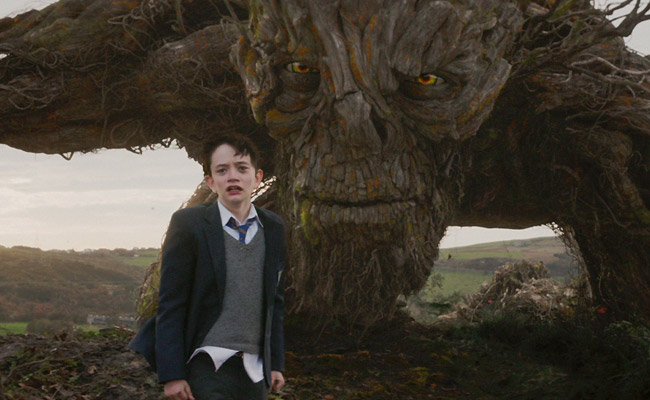
Focus Features
A metaphor is a strong thing in film, because it can be used very effectively or very poorly. Sometimes the metaphor is purely visual, other times it is an audio motif like in Jackie, and sometimes it’s very obvious. Of course sometimes it’s intentionally confusing, like in 2001: A Space Odyssey, but that’s Kubrick for you. But one of the values can be contextualizing something confusing into something palatable which means the audience can absorb a message without having to really think about it.
A Monster Calls comes from director J. A. Bayona and screenwriter Patrick Ness, based on the novel, also by Ness. Patrick Ness wrote the novel based on a draft idea by Siobhan Dowd, who passed away in 2007. Ness has said that he wrote differences into the screenplay from the book, which makes sense. I am reminded of how Gillian Flynn maintained a similar theme and feel between the Gone Girl book and screenplay.
In the movie we focus on young British (perhaps around 12) Conor O’Malley (Lewis MacDougall) who is struggling with something horrible. His mother Lizzie (Felicity Jones) is in the hospital with a terminal illness, and Conor has been sent to live with his grandmother (Sigourney Weaver). Conor’s father (Toby Kebbell) lives in America with his new girlfriend and isn’t really in the picture.
As Conor struggles, he has nightmares about the old yew tree he can see from his bedroom window, a tree that sits near a church graveyard. The yew tree is often associated with death, although the origins are unclear. In the middle of the night at precisely 12:07, Conor is visited by a great monster in the shape of a tree (voiced by Liam Neeson). The monster tells Conor he will deliver three true stories, but after that, Conor must tell his own true story or will be killed.
Each story is told in a beautifully drawn animated style, with interesting fantastical elements that always involve the monster in some way. Each starts as a typical sort of faerie tale story but ends with a grand twist that reflects on Conor’s own life and struggle. Conor’s visions of the monster become intentionally confused, as we are left unsure whether or not the monster is real or just in his mind.
Of course in terms of the movie, as a movie, the monster’s stories are metaphors that represents Conor’s life and pain in different ways. The final resolution and realization is very affecting and logical, although it is not any easier to see. There are two great strengths in this movie that they have put to great use: the acting of Lewis MacDougall and the gorgeous animation. The kid is really great, one of the better young performances in a while.
Felicity Jones did well enough in her role of the sick person, although her character is one difficult to pull off. I found Sigourney Weaver’s British accent to be a bit distracting, but her silent moments are very effective. Liam Neeson was perfectly cast as the voice of the monster, soft and sensitive when needed, furious and raging when that is necessary. Considering the story, this is not a happy movie, but it does have its moments of catharsis.
Patrick Ness has said that he wants more movies and stories that talk frankly about disease that kids can understand, because it is something they experience in real life. I’ve heard some talk that this movie is just for adults, which I think is shortsighted, but it does take the right sort of situation for a young person to sit through such a sad movie.
Much like many movies during the award season, this is a well done, very sad movie. But it has a message many of those don’t, and that is something that elevates it.
